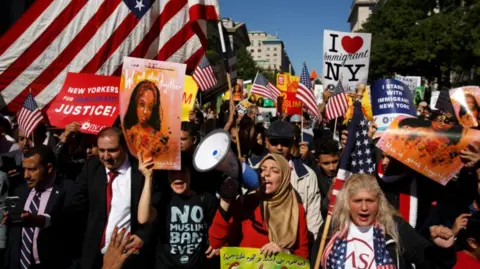Understanding Trump’s New Travel Ban: Context, Implications, and Legal Landscape
Authored by: Emily Atkinson and Neha Gohil, BBC News

Trump’s first travel ban triggered protests across the US in 2017
In a significant political move reminiscent of his earlier presidency, US President Donald Trump has rolled out a sweeping travel ban targeting individuals from 12 nations, revisiting a contentious facet of his administration’s immigration policies. Yet, this new iteration comes with notable modifications aimed at sidestepping the legal turmoil that defined his first travel ban.
Background on the First Travel Ban
The initial travel ban, which aimed at seven predominantly Muslim countries, sparked immediate and widespread backlash when it was instituted just a week into Trump’s first term in 2017. Dubbed the “Muslim ban” by critics, the move led to mass protests and chaos in airports across the nation. This ban was not only met with public outrage but also faced a series of legal challenges, with opponents arguing that it was unconstitutional due to its discriminatory practices.
The original ban underwent two amendments in response to various court rulings, which deemed the initial orders as illegal. Ultimately, a scaled-back version of the ban managed to survive judicial scrutiny, being upheld by the US Supreme Court in 2018.
Key Changes in the Latest Travel Ban
Legal experts suggest that Trump’s latest travel ban reflects lessons learned from the past. Christi Jackson, an immigration law specialist, noted that the new policy appears more legally robust. Unlike the original, which lacked clarity and precision, the latest order is described as “wider in scope” with “clearly defined exemptions.”
Whereas the first ban explicitly targeted Muslim-majority countries, the new restrictions do not present Muslim faith as the primary criterion. Instead, the 12 countries subject to stringent limitations include predominantly Middle Eastern, African, and Caribbean nations like Afghanistan, Iran, and Somalia, with another seven nations, including Venezuela and Cuba, facing partial restrictions.
Rationale Behind the Ban
Trump has justified the travel restrictions by citing concerns over national security, particularly in relation to terrorism. He indicated that the severity of restrictions would correlate with the perceived threat level from specific nations. However, apart from Iran, no other country listed in the outright ban is recognized as a state sponsor of terrorism by the US government.
As an example, Trump referenced a recent incident in Boulder, Colorado, where an Egyptian national was arrested for throwing Molotov cocktails at a demonstration. Despite this connection, Egypt itself is not on the ban list, raising questions about the criteria for these decisions.
Legal Challenges Ahead
The new travel ban has prompted mixed reactions globally, particularly from the targeted countries. Venezuela characterized the Trump administration’s stance as one of supremacy, while Somalia expressed a willingness to engage in dialogue regarding the restrictions.
Critics argue that, similar to the original ban, this new iteration could face judicial challenges. Legal expert Steven D. Heller highlighted a potential lack of clarity in the administration’s justification for the bans, particularly the vague reference to “overstay rates.” Such ambiguity may serve as fertile ground for future legal disputes.
While existing US law grants the president extensive powers over immigration policy, attorneys like Shabnam Lotfi acknowledge that the revised ban’s wording makes it harder for large groups to file collective lawsuits. Given the structured nature of the new travel document, including varying limitations for different countries, it appears that more thought was invested in its crafting, thereby complicating potential legal challenges.
Implications for Visa Applicants
The ramifications of the new travel ban extend beyond immediate travel restrictions, particularly affecting students and other visa applicants abroad. Individuals caught in administrative processing or those who have won diversity visas may find themselves stuck, with diminished chances of obtaining the needed documentation to enter the US.
Moreover, significant investments from individuals seeking EB-5 visas, whom surplus funds have been allocated to the US economy, are also in jeopardy. H-1B visa holders, who have been waiting to return to their US jobs, face additional barriers due to the new regulations.
Community Reactions
Public response to the new ban is mixed, reflecting deep divisions within the US regarding immigration practices. Protests similar to those seen during the initial travel ban may again emerge as communities across the nation rally against what they regard as an affront to human rights and an infringement on civil liberties.
The complex landscape surrounding immigration reform under Trump’s latest travel restrictions suggests that this topic will continue to evolve, impacting lives and policies on multiple fronts for the foreseeable future.
This article incorporates reporting from Leyla Khodabakhshi.




